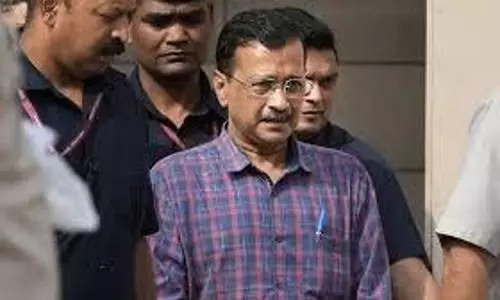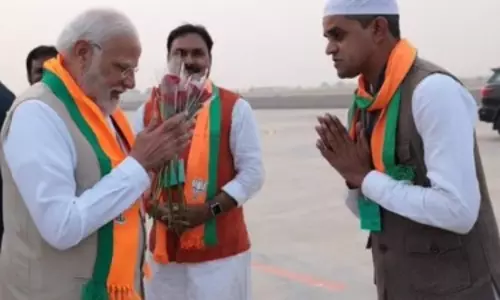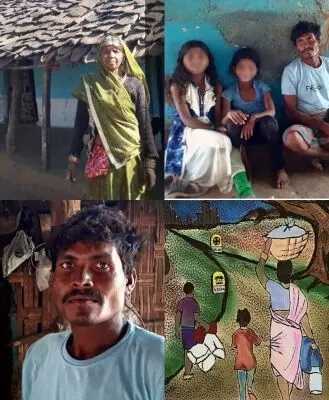
No jobs and food, MP's Khandwa witnesses tribal exodus
text_fieldsKhandwa (Madhya Pradesh): An estimated one lakh people migrate from the state's tribal areas including Khandwa, Khargone, Barwani and Burhanpur of Nimar in search of livelihood each year.
Most of them end up in Maharashtra, Telangana, Karnataka, Goa and Andhra Pradesh—so did 35-year-old Poonamchand Sitaram Gautam.
A resident of Khandwa district, Gautam returned from Koratala in Telangana after working his fingers to bone as a construction worker there.
He was like most Adivasis in the region who move to other states only to face grimier conditions, often to be cheated of the wages and held hostages by employers.
"I have a wife and five daughters, but there's no work in the village. Even if you find some, the panchayat takes months to pay us," Gautam said.
"Under the Public Distribution System, we receive just 5 kg of foodgrains for each member of the family every month. But these rations barely last a fortnight," he added.
Mostly tribal living village of Dabhia, where he lives, in Khalwa region, there is hardly anything to eat.
A field study in 12 states by Ekta Parishad ranks Madhya Pradesh top in terms of highest inter-state migration rate.
Where the state stands at 32.39 per cent in migration, Khandwa is leading among the districts.
Between 5,000 and 10,000 tribals migrate out of Khalwa every year to work as labourers in other states, an estimate by a local body says.
Khalwa is spread over 70 to 100 km from the district headquarters. Most of Khalwa falls under the jurisdiction of the forest department, with 90 per cent of the population living in remote areas.
Visiting Dabhia village, 101Reporters found each house had at least two members migrated to other states for work.
Gautam's 16-year-old daughter Garima built drains under the Mahatma Gandhi National Rural Employment Guarantee Act (MGNREGA) last year.
She worked eight hours a day for five weeks but was paid only two weeks' wages.
Her mother Rajni Bai questioned the panchayat, but was told the money had been transferred to her account. They have yet to receive it.
The 60-year-old Jamna Kallu Chauhan worked for the panchayat eight hours a day last two weeks.
Chauhan was paid only for one week. The panchayat office in Semliya wouldn't listen to Chauhan's request for pay.
The sarpanch of Semliya panchayat Pyari Bai Ramesh Takher, however, denied any outstanding payments.
"No labourer's wages are outstanding with the panchayat," she claimed. "The money has been transferred into their accounts. The villagers often withdraw money and blame us later."
No logic to the numbers
Kishore Kumar Uike, the CEO of Janpad panchayat, said the district was giving up job opportunities for the area's local residents.
"Janpad panchayat has created employment for 17,000 labourers in the development block," he said. "I don't understand why people are migrating for work. Even today, if anyone approaches us for work through the panchayat or district, we will provide them with work."
From May 2020 to May 202, according to the MGNREGA website, which currently seems inaccessible, 3,821 days of wages were created in Khalwa, helping 644 workers.
The works included pond construction, canal deepening and dam checks. The website has had no updates since then.
A hunger-induced distress migration
According to Prakash Michael, treasurer of the Spandan Samajseva Samiti, an organisation working to provide nutrition and employment to these tribals, the primary cause for migration is the food crisis in the region, which has increased in the last couple of decades.
"Adivasis have ditched growing traditional crops and turned to cash crops such as soybean. Bajra and other millets such as koda and kutki, once the backbone of their nutrition, are no longer visible in the fields. They use most of the money they earn by selling produce to repay loans. They are left with very little foodgrains, so this is basically hunger-induced distress migration," Michael told 101Reporters.
This explanation holds true for 60-year-old Jamna, who now lives alone in her hut. Her husband, Kallu Chauhan, had "taken up a contractual job of harvesting moong in Nahali, Harda district, despite being terribly ill. The family's financial crisis had pushed him to move, and within three days, we lost him to the illness."
One lakh labourers migrate from Nimar
Spandan Samajseva Samiti, which collects data for land surveys, estimates that around 1 lakh people from Khandwa, Khargone, Barwani and Burhanpur of Nimar district migrate to Maharashtra, Telangana, Karnataka, Goa and Andhra Pradesh each year.
This large workforce is unorganised and unprotected. They are neither insured by their employers, nor are they provided safety equipment for work. This often leads to their death. Since there are no official records of migrant labourers, employers escape responsibilities by deeming them mere accidents.
Under the Inter-State Migrant Workmen Act, the employer must provide migrant workers with food, lodging, healthcare and social activities. Labour officials must be around to ensure workers' rights. Also, the figures of migrant workers must be displayed on the Migrant Labourer Portal, though no data appears to track this information.
District Labour Officer S.S. Alawa explained that the act "can be invoked only if the contractors or residents officially inform the department about their migration, which the tribals here fail to do. Hence, they cannot exercise any rights under this law".
Wily contractors, callous employers
Furthermore, contractors arrange locals to reach out to labourers. Taking advantage of their knowledge of the Korku dialect, they lure the tribals promising huge money in wages. Tribals are often paid an advance, to make them believe the deal.
They would go on convince their friends and neighbours, too. On the appointed day, the contractors would transport migrants in vehicles at night.
The workers wouldn't find out where they were taken. For days and weeks they would not discover which village, district or state they were working. The contractor shares his mobile number to placate the families, but the phone is often turned off once they set out with the migrant labourers.
Daji Lofa, a 30-year-old who returned from harvesting sugarcane in Maharashtra, recalls a contractor who had come to the village before Diwali last year and promised everyone cane-cutting work for three months.
He had also promised them a lot of money, which would help them stop working for the rest of the year. He had paid an advance of Rs 7,000 to one of the workers. A week after Diwali, the contractor arrived at 11 pm with two mini Eichers and took 40 people with him. But they were refused pay after putting in hours of hard labour.
The tribals of Khandwa are trying to escape such experiences
Babu Mangal was among workers from Khalwa held hostage in Pandharpur, Maharashtra last year. He said they were treated worse than animals. He and his wife continued harvesting sugarcane despite being terribly ill.
"We didn't get any treatment when we were ill. We had to arrange for our own food and sleep in the open fields or inside warehouses," the 50-year-old told 101Reporters.
Sunita Kajle from Langoti village went to Maharashtra to work, when she discovered she was pregnant. She was forced to continue work long hours. She had no proper nutrition until the sixth month of her pregnancy. Later she gave birth to a malnourished daughter after returning.
In some cases, the tribals bear the consequences of this survival act -- the migration -- longer than they could have anticipated, at times for life.
Take Munni Bai, for instance. She injured herself while working at a brick kiln and continues to live with it. She had dropped bricks on her feet, which initially caused swelling and later became worse. Munni can no longer work due to her injured leg and has received no compensation from neither the contractor nor the government.
Socio-economic factors
Khandwa district has a population of 13,10,061, of which 80.20 per cent live in villages. The literacy rate of Khalwa is only 43.10 per cent (51 per cent among males and 34 per cent among females). Despite this, the proportion of labour in Khalwa is 17.38 per cent, of which 9.66 per cent is male and 7.72 per cent female. Agriculture is the primary source of income, but the people here barely own any land, 2 acres per family on an average.
The percentage of total agricultural farmers in the tehsil is 14.08 per cent in Khalwa, of which 9.88 per cent are male and 4.20 per cent are female. There's no focus on employment-oriented education, and the entire sector is dependent on resources from agriculture and forests.
In 2009-2010, the state government had created natural resource-related jobs in Awliya under the Small Forest Produce Association, for the manufacture of incense sticks, perfumes, bamboo furniture and household items. Initially, over a 100 people were employed under this scheme, but they could not grow beyond making incense sticks, which wasn't financially viable and hence, discontinued.
Source: IANS
























